When I wrote a review of Conference back in April, I noticed that the prayers were noticeably longer in this Conference than last October’s. It got me to thinking that although I have an intuitive sense of what feels like a short or a long prayer, I don’t know what actually counts as a short or a long prayer in comparison with other prayers in Conference. I was also interested to know whether there has been any trend over time in prayer length. Like maybe a new Church President sent a memo to all prayer-givers to tell them to hustle things along in their prayers, so they suddenly got shorter. And of course now that we’ve had women praying in general sessions for several years, an obvious question is whether their prayers are similar in length to the men’s or shorter (or longer!) My guess was that they would be shorter, given that men are encouraged to take up more space in every other area of the Church.
To answer these questions, I watched a bunch of videos of the beginnings and ends of General Conference sessions and noted who was praying and timed the prayers. The videos came from the Church’s General Conference YouTube channel and to the General Conference page on the Church website. Although there are videos of individual talks going back to 1971, there are only full session videos going back to about 2005, with occasional sessions or parts of sessions available for another decade before that.
As an aside, I’m serious about saying “parts of sessions.” The Church’s YouTube channel videos of full sessions are good for recent Conferences, but as you go back, they have lots of errors. There are several videos that are labeled as full sessions, but they end after five or ten minutes. There are a few that are mislabeled, which I only realized when the introduction in the video itself said it was a different year than the labeling of the video did. There’s even one video that shows the same session twice, back-to-back. On the Church website itself, there are a lot of sessions that claim to have video (i.e., there is a link to watch) but then they can’t be played. And there’s also at least some mislabeling. Fortunately, in at least some cases, the audio-only recording works. I submitted feedback on the Church’s website, but I couldn’t find a way to do so on its YouTube Conference channel. I know this is an extremely long shot, but if you happen to know how I could reach whoever is running it, I would be happy to supply a list of issues that need to be fixed.
Okay, on to the data! I noted lengths for 381 prayers between 1996 and 2020. (You’d think I would have had an even number since each session has two prayers, but like I was complaining about above, a few of the videos include only the opening prayer.) The average length was 93 seconds. This is within the range I expected, and it’s also consistent with my sense of what constitutes a long prayer, as while watching all these prayers, I typically started to feel like they were dragging when they went over about 100 seconds. It’s just unfortunate that older session videos aren’t available too, because I recall Conference prayers in the 1980s when I was a kid sometimes going on what felt like forever. Looking back, though, I wonder if it wasn’t just my age and shorter attention span that made them feel extra long.
This graph shows average length across time.
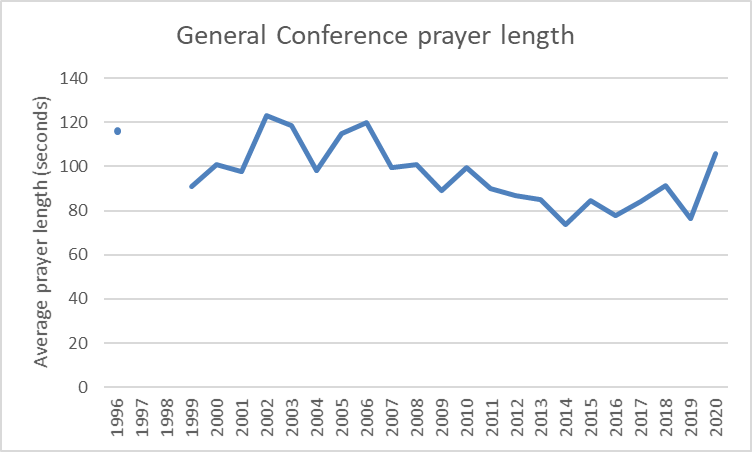
Note that the dot for 1996 is just because there were no recordings available for 1997 or 1998. It looks like maybe prayers were longer in the Hinckley years than in the Monson years. Maybe.
This next graph shows boxplots by year. The boxplots represent the same data as the graph above, but instead of just showing the average, they show five: the median (middle value when prayer lengths are ordered by size), the 25th percentile (value that 25% of prayer lengths are less than or equal to), the 75th percentile, the minimum, and the maximum. For each year, the box shows the 25th percentile at the bottom, the median in the middle, and the 75th percentile at the top. The lines extending out from the box (called “whiskers”) reach to the minimum and maximum (unless the minimum or maximum is too far out, in which case it’s shown as a point–the Wikipedia article linked above explains how “too far out” is determined).
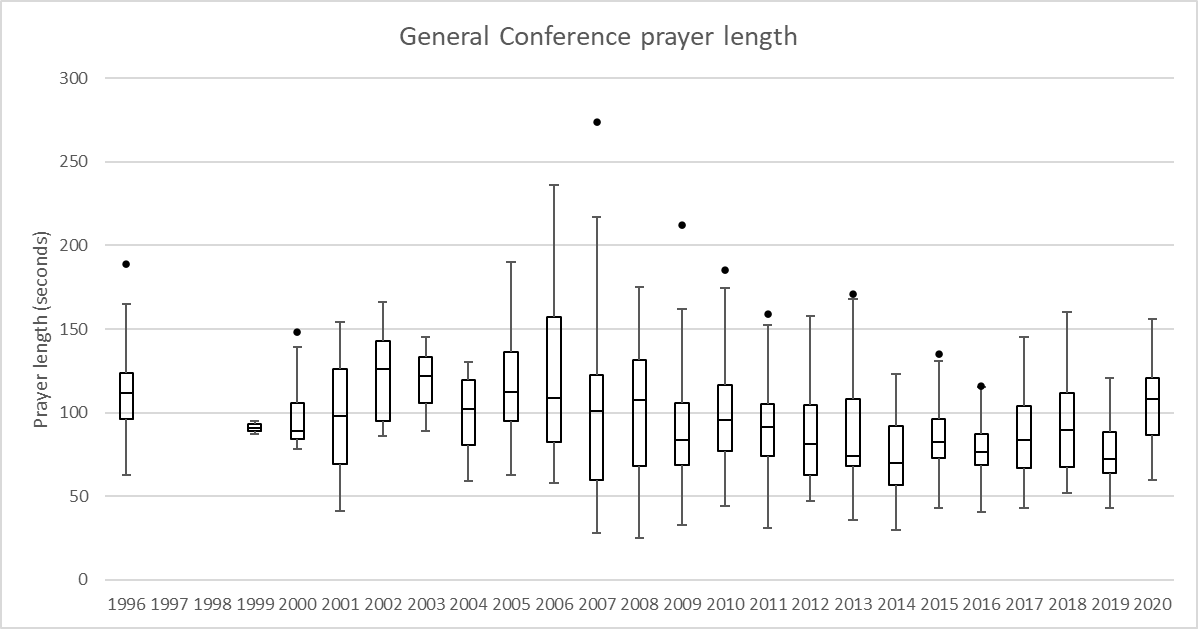
From this graph, it looks like maybe what happened in the Monson years was a reduction in variability as much as a change in average level, as the boxes get smaller and the whiskers get shorter. The change, if it’s even more than random variability, doesn’t look too abrupt, though, so I suspect that it’s more likely just drift than a directive from the top. One thing to note is that the 1999 box looks tiny only because I just have one session from that year.
Male prayer-givers averaged 97 seconds, and female prayer-givers averaged 76. This seems like a pretty large difference. However, the female group includes a bunch of ordinary members who gave prayers in some of the old General Relief Society and Young Women’s sessions (in 2013 and before). First, I had never known that this was even a thing, as I never watched these sessions, but only ever read talks from them. But more importantly, I think ordinary members would clearly be expected to give shorter prayers than GAs and general officers who are more accustomed to standing at the pulpit in front of thousands of people. When I excluded ordinary members, the difference was much smaller, with men still at 97 seconds and women at 88. I compared the women’s and men’s prayer lengths using a permutation test, and the difference was not statistically significant (p = .095; typically p < .05 is used as the threshold for statistical significance). Still, I suspect that this is a real difference, and is probably only showing as nonsignificant because the sample size is not yet large enough.
This next graph shows women versus men’s average prayer length by year, again excluding ordinary members from the women.
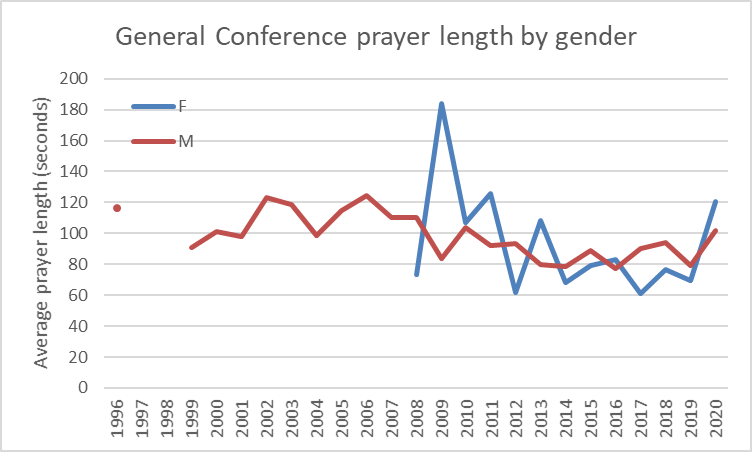
The women’s line moves much more dramatically than the men’s, but this is just because of the small sample size. For example, in 2009, when the women’s average was an amazing 184 seconds, there were only two prayers given by women (in the RS session–the YW session was excluded because prayer givers were ordinary members).
Here is a list of the six prayers in the data that were longer than three minutes.
| Name | Conference | Session | Prayer | Length (sec) |
|---|---|---|---|---|
| D. Rex Gerratt | 2007 April | Sunday afternoon | Closing | 274 |
| W. Craig Zwick | 2006 October | Priesthood | Closing | 236 |
| Carole M. Stephens | 2009 October | Relief Society | Closing | 212 |
| Darwin B. Christenson | 2005 October | Saturday morning | Closing | 190 |
| Lance B. Wickman | 1996 October | Sunday morning | Opening | 189 |
| Richard C. Edgley | 2010 April | Sunday afternoon | Closing | 185 |
Conference prayer-givers typically don’t get to give more than a handful of prayers in their church career, so it’s hard to say if those who give longer or shorter prayers are actually showing differences in their prayer styles, or if it’s just random variation. With that caveat, here are the top six in average prayer length among those who have given at least two prayers.
| Name | Prayers | Avg length (sec) |
|---|---|---|
| Carole M. Stephens | 2 | 189 |
| W. Craig Zwick | 4 | 159 |
| Marlin K. Jensen | 3 | 152 |
| Lance B. Wickman | 3 | 149 |
| Mervyn B. Arnold | 2 | 147 |
| Paul K. Sybrowsky | 2 | 147 |
One pattern I hadn’t been planning to look at but stumbled on was that givers of closing prayers in general sessions give shorter prayers when they start very close to the two-hour mark. I’m guessing this is because these sessions are shown on live TV, and they want to be sure to fit the session into the allotted two hours. Here’s a scatterplot showing prayer length as a function of start time for closing prayers in general sessions. (Priesthood, women’s, RS, and YW sessions are excluded.)
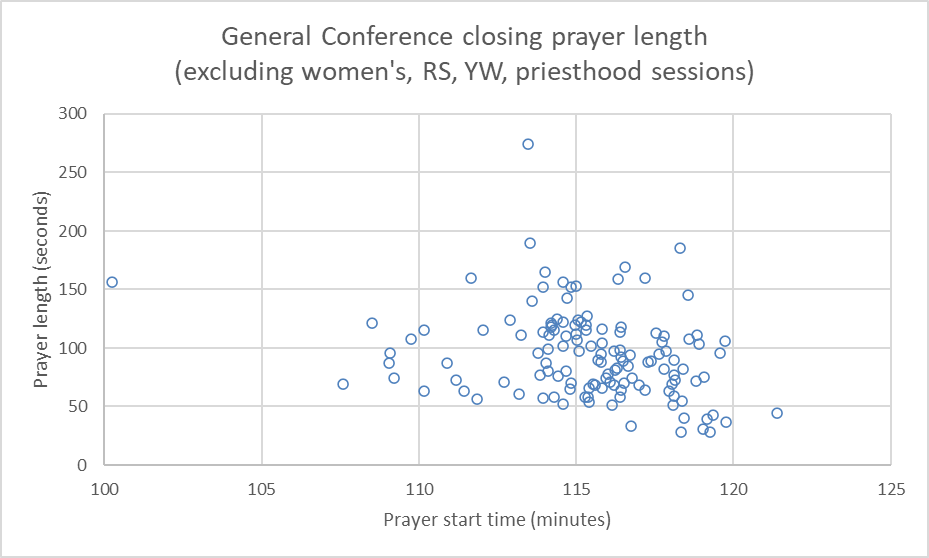
Each closing prayer is represented here by a little circle, with its horizontal position representing the starting time of the prayer in the meeting, and its vertical position representing its length. There’s not a really strong relationship overall, but if you look at the 50-second line (which qualifies as a very short prayer by Conference standards), nobody gave a prayer shorter than that (below the line) when starting at the 115-minute mark or before, but after it, there are several. (If you want to see one, here’s an example from April 2016, where the giver of the closing prayer started after the 119-minute mark and gave a 39-second prayer. And not only was the prayer short, he raced to the pulpit, and was starting as the choir sat down. He was clearly in a rush to finish.)
In this next graph, I’ve put the starting times in one-minute bins between 113 and 119 minutes, and then shown the average prayer length for each bin. I think it shows the relationship more clearly.
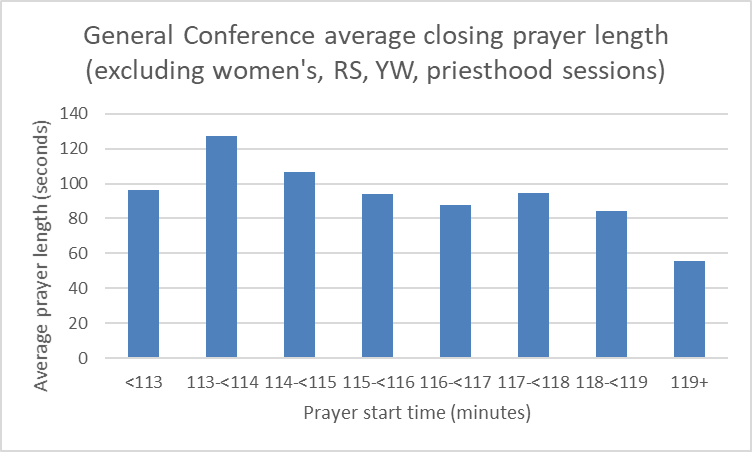
Prayer-givers starting at the 119-minute mark or later average prayers shorter than 60 seconds. In comparison with earlier starting times, this even achieves statistical significance using a permutation test (p = .007). I’m sure that of all the non-earth-shattering statistics I’ve put together over the years, this might qualify as the least earth-shattering: prayer-givers are aware of session length constraints!
Just for comparison, here’s a similar scatterplot for opening prayers, again, only in general sessions.
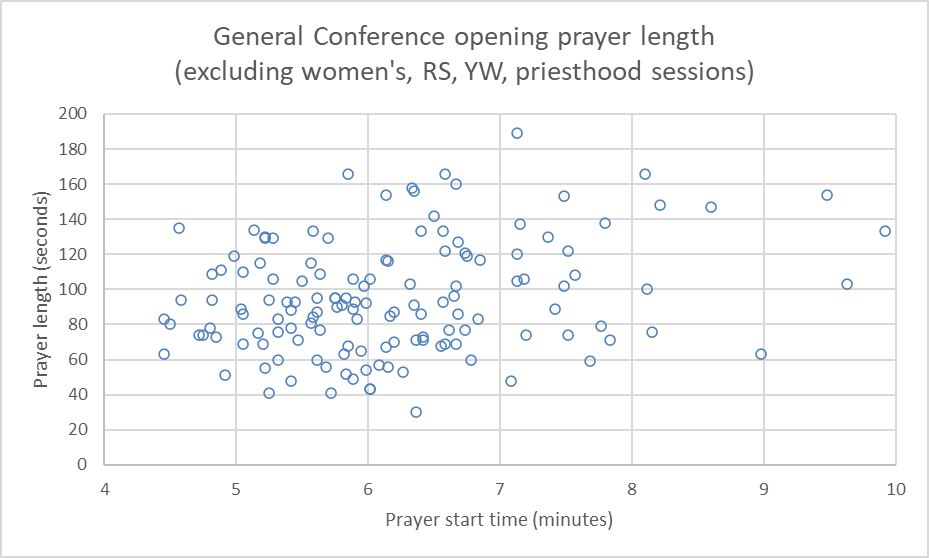
It looks like there’s some tendency for prayer-givers to give longer opening prayers the later they start. Again, here are the same data with the starting time in one-minute bins from 5 to 9 minutes.
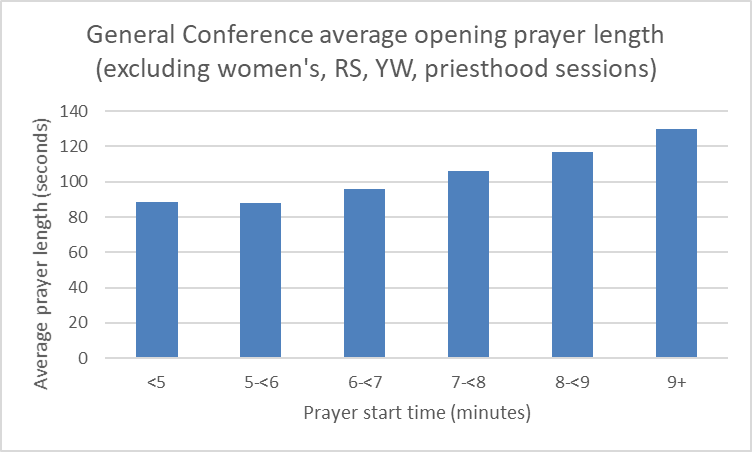
It’s a funny little trend, but without even a guess at an explanation, I wonder if it isn’t just noise.
Finally, I didn’t systematically note the content of prayers, but I did listen to a lot of them at least in part, and I have a few random comments:
- I’m not sure if prayer-givers who say “We thank thee, O God, for a prophet” think they’re being original or not, but at this point, I think it’s achieved vain repetition status.
- Ditto for prayer-givers who open with the opening lines of the Lord’s Prayer.
- I know that the over-use of appositive phrases beginning with “even” (e.g., “the prophet, even Russell M. Nelson”) is just a Mormon (GA) thing, but it strikes me as a little hilarious. I’m imagining a dialogue that goes like this. Prayer giver: We pray for our beloved prophet… God: Which prophet? Prayer giver, continuing: …even Russell M. Nelson. God: Thanks, I had no idea which one you were talking about!
- It sure seems like prayer-givers pray more for issues of concern to political right-wingers (e.g., military) than those of concern to political left-wingers (e.g., poverty). I guess this shouldn’t be surprising.
- When a man stands up to give a prayer and he puts his hands on the sides of the pulpit, settle in, because he’s signaling that he’s going to belt out a nice long prayer. Here’s an example from 2008.
- Women more often fold their arms at the pulpit than men do. Interestingly, from the prayers I’ve seen, men never folded their arms while praying until after 2013, when women started praying in general sessions. Here’s an example of a male prayer-giver folding his arms from 2014.
- Balding men with comb-overs who give prayers should maybe try not to bow their heads too low if they don’t want to reveal their comb-overs to the world.
- Probably the strangest prayer I saw in watching so many was the opening prayer of priesthood session in April 2010, where the Seventy giving the prayer kept looking up at the congregation as though he were giving a talk.
Thanks, this is fascinating! Appreciate all of your effort and insight. I’ll definitely pay more attention to the prayers next time 😉
Thanks, Anita! I’m glad you enjoyed it.
I could be getting details wrong, but I remember a long time ago hearing a minor GA tell a story about coming to the pulpit during general conference to give a closing prayer, and the teleprompter telling him he had 30 seconds.
Thanks, Quentin! That totally makes sense that the powers that be who are managing the timing would be right on top of closing prayer length when there’s little time to spare!
I have some audio recordings of conference sessions from 1981. And it’s entirely possible I might have some others in a box somewhere. But the real question is whether I can find a cassette player in the back of a closet or something.
I seem to remember some very long prayers when the final speaker finished early. That might have happened when President Kimball or Benson was ill and only bore a short testimony at the end of the session.
That would be great, Left Field! But no worries if it turns out not to be possible. This is obviously pretty low stakes. What I really wish is that whoever is running things at the Church would just put up the full session recordings back to 1971. I assume they must have them, since they’ve extracted the talks out.
This is very interesting. Thank you. I’ve often felt like those saying a prayer were giving sermons and not saying a regular prayer like normal real people
President Packer was pretty much a 60-second prayer and 90-second testimony guy. As a member of a bishopric in the 3-hour block era, we thought that if people started giving 90-second testimonies, we’re sunk. The meeting would be over in less than half the regular time and we would all have to sit around and listen to organ music until Sunday School was supposed to start.
I actually have some other tapes that I’ve been wanting to play, so I have other motivation to find a tape player. I did find an old one in a closet, but it’s not working. Until a couple years ago, I had a 2002 Carolla with a tape deck, but that’s not an option any more. I remember we had a boom box sometime in the past. Perhaps that will turn up if I poke around a little more.
I also remember a General Authority–Elder John K. Carmack–relating in our Stake Conference the hilarious little anecdote about coming to the lectern to give the closing prayer in Conference, and having a monitor flashing the short number of seconds left!
Thanks for the fun analysis, Ziff! A lot of work, and it’s appreciated.
Your statistical analyses are always interesting to read, even if I don’t have much to contribute.
On this one, though, I have a fun anecdote. This happened in sacrament meeting, at a missionary farewell, back when those meant the family got the whole meeting. Grandma must have been disappointed that she didn’t get to speak, but she did get to give the opening prayer. She basically gave her talk in the prayer, describing how special it was to be with her grandson when he got his endowment, and telling Heavenly Father a few stories of him growing up and what a great missionary he was going to be. It went on for several minutes.
There is some sort of visible timer for the person who gives the closing prayer. Conference was on TV in Utah and they don’t want to go over the time. When the prayer is longer, it is because the people giving their talks spoke more quickly than they had expected based on rehearsed times. People are not machines, and changing their speed in taking just slightly can make a big difference over a 10-15 minute talk. You may also notice that the choir shortens songs by cutting out entire verses is the meeting is running long.
I got a tape player and got a couple of data points.
April 1975 conference.
Saturday morning (third) session, closing prayer by Edwin Q. Cannon, former president of the Switzerland Zurich mission. Time: 1:38
Saturday afternoon (4th) session, opening prayer by Clyde J. Summerhays, former president of the Ireland Belfast Mission and now Assistant to the Director of the Visitor’s Center on Temple Square. Time 1:39
I timed just from the first to the last word of the prayer, ignoring the dead air before and after. I didn’t have the beginning of the third session, so I don’t know how much time was remaining, and even if I had the whole session, the timing might be off because of the unknown time for turning the cassette over. I’ve got a few more tapes I haven’t listened to.
April 1981, Saturday afternoon
Opening Marion D. Hanks, 2:36
Closing John H. Groberg, 1:08
October 1981, Saturday afternoon
Opening Joseph B. Wirthlin, 2:59
Closing Robert L. Backman, 2:52
October 1981, Sunday morning
Opening George P. Lee, 5:02
Wow! Thanks for the data, Left Field! That five minute marathon from George P. Lee is particularly interesting. (Also, you’re timing exactly the same way I did–first word to last word.) I also didn’t know that it wasn’t always Seventies giving the bulk of the prayers. It seems like when Let Women Pray was pushing for women to pray in Conference, there was a Church comment of some kind about how it was mostly the Seventies’ job to do it.
Jks and Hunter, thanks. That makes sense that there would be a mechanism to let prayer-givers know how much time they have left. I think it’s interesting that a GA told a story about it. I wonder if having the timer right there is kind of an added stress in an already-stressful situation.
Melinda, thanks! I’m glad you enjoyed the post. And that’s a great story about someone put out that they didn’t get to give a talk, so sharing all their thoughts in the prayer!
rickpowers, on Boyd K. Packer, one thing I wish I could get too would be prayer lengths for the Q15. But of course they’re typically not the ones praying in Conference. It would probably show nothing interesting, I suspect, but I also wonder if it might show which of them might be willing to take up a lot of social space by giving long prayers. That’s also a funny point about F&T meeting being pretty much designed for long testimonies, given that it’s not typical for 40+ people to get up in one meeting.
Peggy, exactly! My impression is that the people giving prayers in Conference do sometimes slip into sermonizing mode for sure.
In the mid-1970s when they switched from 3-day to 2-day conference, they no longer were able to have all general authorities give a conference address, as had been the previous practice. When that happened, they switched to having prayers given by general authorities who weren’t assigned to speak. Previously, prayers had been given by stake presidents and the like.